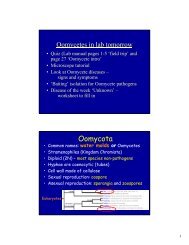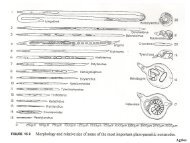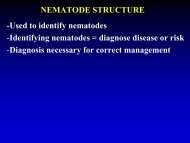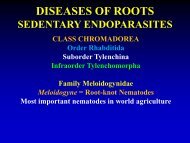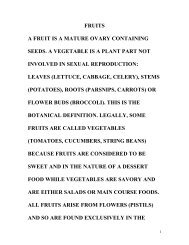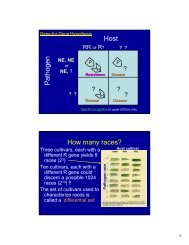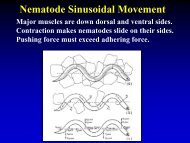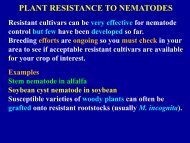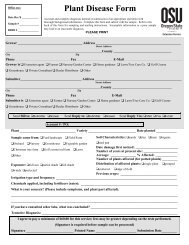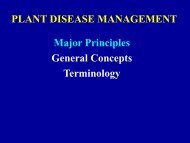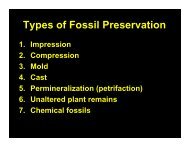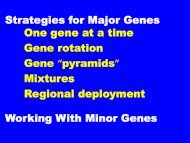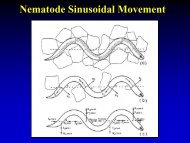Sedentary endoparasites
Sedentary endoparasites
Sedentary endoparasites
Create successful ePaper yourself
Turn your PDF publications into a flip-book with our unique Google optimized e-Paper software.
DISEASES OF ROOTS<br />
SEDENTARY ENDOPARASITES<br />
CLASS CHROMADOREA<br />
Order Rhabditida<br />
Suborder Tylenchina<br />
Infraorder Tylenchomorpha<br />
Family Meloidogynidae<br />
Meloidogyne = Root-knot Nematodes<br />
Most important nematodes in world agriculture
*<br />
Agrios
Stained Adult Female Meloidogyne<br />
K.J. Merrifield
Meloidogyne spp.<br />
Root-knot Nematode<br />
<strong>Sedentary</strong> Endoparasite
Meloidogyne spp. = Root-knot Nematode<br />
Eggs overwinter in the soil and in decaying root tissues.<br />
The nematode molts from J1 to J2 within the egg.<br />
Egg hatch does not require presence of root exudates.<br />
K.J. Merrifield
Meloidogyne spp. = Root-knot Nematode J2<br />
J2 hatches from egg = J2 and males are only stages in soil<br />
and are recovered from soil samples<br />
J.D. Eisenback<br />
Nemaix 1
Meloidogyne spp. = Root-knot Nematode<br />
J2 = only infective stage<br />
Penetrate at root tip or in the region of elongation<br />
Migrate through cortex and select feeding site<br />
R.S. Hussey
Meloidogyne spp. = Root-knot Nematode<br />
J2 begin feeding and become sedentary,<br />
grow in thickness, becoming "sausage-shaped" and molt<br />
to become J3. Develop further and molt to J4.<br />
J2 J3 J4<br />
E.C. Bernard
Meloidogyne spp. = Root-knot Nematode<br />
The root's physiology is changed by the nematode and<br />
"giant cells" form around the head<br />
to nourish the nematode<br />
N.T. Powell
Meloidogyne spp. = Root-knot Nematode<br />
Female J4 molt and grow to a "pear-shaped" adult<br />
with the posterior just beneath the root surface.<br />
The root forms a gall around the female.<br />
R.S. Hussey
Meloidogyne spp. = Root-knot Nematode<br />
Males become "worm-shaped" again, developing within<br />
the J4 cuticle like within an egg. The male emerges from<br />
the J4 cuticle and leaves the root to search for a female.<br />
Males are usually rare and have not been reported<br />
for some species.<br />
R.S. Hussey
Male Root-knot Nematode<br />
Migratory stage in soil<br />
G.S. Abawai
Meloidogyne spp. = Root-knot Nematode<br />
The gall may rupture as the female enlarges allowing the<br />
male access to the female and allowing the female to lay<br />
eggs into the soil. The female does not need to be<br />
fertilized by the male to lay eggs.<br />
R.S. Hussey
Meloidogyne spp. = Root-knot Nematode<br />
Over 300 eggs are laid into a gelatinous matrix (egg sac)<br />
which may be inside or outside the root tissues depending<br />
on the position of the female. Eggs may hatch immediately<br />
or remain until the following spring.<br />
A typical life cycle<br />
takes 3-4 weeks at<br />
25-30 C.
Meloidogyne spp. = Root-knot Nematode<br />
106+ species<br />
99?% of all root-knot nematodes are:<br />
Meloidogyne incognita 46%<br />
Meloidogyne javanica 44%<br />
Meloidogyne arenaria 7%<br />
Meloidogyne hapla 6%
Meloidogyne incognita<br />
Perineal Pattern<br />
Used to determine species<br />
H. H.Triantaphyllou
Multiple side roots may develop = "hairy root".<br />
Meloidogyne spp. = Root-knot Nematode<br />
Symptoms<br />
Nematodes stimulate gall formation.<br />
Galls with one nematode are about twice the<br />
normal root diameter, multiple infections in same<br />
location can create galls 1-2 cm in diameter.<br />
M.A. McClure<br />
Nemapix 1
Multiple side roots may develop = "hairy root“.<br />
Lettuce Seeding Infected<br />
with Meloidogyne hapla<br />
Gall with lateral<br />
branch roots<br />
H.J. Jensen
Symptoms of Root<br />
Knot Nematode<br />
ize and shape of galls vary considerably between<br />
pecies or races of nematodes and host species or<br />
ultivar.
In light infections, roots may continue to grow past the<br />
infection. However, in heavy infections, a mass of short,<br />
swollen "clubbed" roots may develop.<br />
H.R. Garriss
Roots often are heavier<br />
than normal and become<br />
nutrient "sinks"<br />
diverting nutrients from<br />
plant tops.<br />
Symptoms of Root<br />
Knot Nematode<br />
on tomato<br />
Rates of photosynthesis<br />
are decreased .
Vascular damage disturbs water & nutrient uptake<br />
so infected plants are stunted, wilt easily and often<br />
have signs of nutrient deficiency, potassium.<br />
R.A. Motsinger
In old infections, roots may decay and plants are<br />
more susceptible to attack by other pathogens.<br />
A. Mani<br />
Nemapix 2
Forking of Tap Root and<br />
Hairy Root Caused<br />
by Melodogyne hapla<br />
H.J. Jensen
Columbia Northern<br />
Uninfected Root-knot Root-knot Uninfected<br />
External Symptoms of Root-knot Nematode
Root-knot Infection sites in Potato
M.A. McClure
Root-knot Infection Site in Potato Tuber<br />
G. Santo<br />
Body of Female<br />
Discoloration From Egg<br />
Mass And Tissue Reaction
Discoloration is increased when<br />
root-knot infected potato tissue is fried
Meloidogyne spp. = Root-knot Nematode<br />
Control<br />
Crop rotation is effective but not always practical.<br />
Resistant cultivars exist for some crops but are<br />
species or even race specific. Examples: lima beans,<br />
peaches, soybeans, tobacco and tomatoes.<br />
Fumigant and nonfumigant chemical nematicides are<br />
frequently used on high cash value crops.<br />
Trap crops, flooding, fallowing, solarization, green<br />
manures, and heat treatment of bulbs are also used<br />
in special instances.
DISEASES OF ROOTS<br />
SEDENTARY ENDOPARASITES<br />
CLASS CHROMADOREA<br />
Order Rhabditida<br />
Suborder Tylenchina<br />
Infraorder Tylenchomorpha<br />
Family Hoplolaimidae<br />
Heterodera = Cyst Nematodes, 67+ species<br />
Globodera = Cyst Nematodes, 12? species<br />
Both genera have species that can be devastating<br />
Life cycles of both genera are similar
*<br />
Agrios
T.O. Powers
Photo from Tom Powers
Disease cycle of the cyst nematode Heterodera glycines<br />
Agrios
Some Cyst Nematodes<br />
Require a “Hatching Factor”<br />
From the Host Plant<br />
Globodera rostochiensis<br />
Eggs and J2s<br />
U. Zunke<br />
Nemapix 1
Heterodera glycines (Soybean Cyst Nematode)<br />
J2 Infecting Soybean Root<br />
J.D. Eisenback<br />
Nemapix 1
Juveniles become sedentary while feeding, swell<br />
and go through molts to become adults<br />
J.D. Eisenback<br />
Nemapix 1
Production of extensive syncytia is induced by the<br />
nematode to support feeding.<br />
B. Endo<br />
Nemapix 2
Adult females enlarge and since root tissue does not expand<br />
around them, they break through the root surface.<br />
Some eggs are laid outside the body in an egg mass.<br />
Caubel<br />
Nemapix 2
Most eggs are retained within the body<br />
E.C. McGawley<br />
Nemapix 1
Mature “lemon-shaped” females of Heterodera die and<br />
become dislodged from the root where they may remain<br />
for many years.<br />
J.D. Eisenback<br />
Nemapix 1
Globodera are similar to Heterodera<br />
but are round in shape.<br />
Mature Female<br />
Potato Cyst<br />
Nematode<br />
Theirry Vrain
Color Changes During Cyst Maturation<br />
Globodera<br />
J.A. Fox
Structure of the vulval cone is used to determine species<br />
of Heterodera<br />
Side View<br />
End View<br />
J.D. Eisenback<br />
Nemapix 1
Cyst Nematodes - Symptoms<br />
Side roots may be initiated and an infected root may<br />
have a "bewiskered" appearance often called "hairy<br />
root".<br />
Yields may be dramatically reduced.<br />
Plants are often severely stunted and may even die if<br />
water stressed.<br />
Plants wilt more easily than normal, uninfected plants.<br />
Disease complexes can occur with other plant pathogens.
Heterodera schachtii on Red Beet<br />
Note White Cysts and Hairy Root<br />
Cysts are a “sign”, not a symptom<br />
Closeup of roots<br />
K.R. Barker
Heterodera glycines on Soybean Roots<br />
R.A. Motsinger
Golden Potato Cyst - Globodera rostochiensis<br />
Pale Potato Cyst - Globodera pallida<br />
Potato Cyst Nematodes Feeding on Root<br />
Ulrich Zunke
Potato Cyst Nematodes Reduce Plant Growth<br />
Yield Loss Can Be as High as 80%<br />
Bonsak Hammeraas
Heterodera schachtii<br />
on Cabbage<br />
D.W. Dickson
Cyst Nematodes - Control<br />
Fumigant and nonfumigant chemical nematicides.<br />
Some resistant cultivars of certain crops are available<br />
but are often race specific and if they are used too<br />
often, can "select" for populations that are capable of<br />
reproducing on them.
Plot of Soybean Cyst Resistant Soybeans Growing<br />
in a Field Infested With Heterodera glycines
Cyst Nematodes - Control<br />
Long rotations with nonhost crops. Some eggs have<br />
remained viable in soil for 15 years, or more, in the<br />
absence of a host crop.<br />
Rotations and use of resistant cultivars are sometimes<br />
regulated and enforced by governments.<br />
Early planting i.e. sugarbeets can be planted early and<br />
get a jump on nematode populations. Can have an<br />
adequate root system developed that can tolerate<br />
nematodes when it becomes warm enough for them to<br />
become active.
Questions?<br />
Globodera pallida<br />
Slide From Tom Powers
Brown Cysts of Globodera<br />
Opened to Expose Eggs and J2<br />
J.A. Fox
Eggs of Cyst Nematode May Stay<br />
Protected Inside Cyst for Years<br />
Ulrich Zunke



